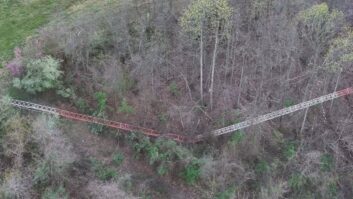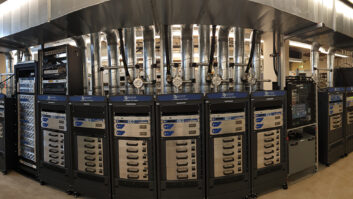WASHINGTON
An epidemiological study by South Korean researchers shows that children who live close to AM radio transmission facilities may have a higher risk of leukemia.
The study is flawed and inconclusive, say American radiofrequency experts familiar with electromagnetic fields and their effects on the human body.
The research, released this summer, is the latest in a series of published findings seeking links between electromagnetic fields (EMFs) and cancer. Similar claims have been made against power lines and cell phones in recent years.
Epidemiology involves the study of relationships between the occurrence of diseases in large populations and environmental influences that could cause epidemics. The South Korean study included measurements of the electrical and magnetic fields surrounding AM transmission sites throughout that country and used a mathematical model to estimate residents’ exposure to radiation.
The study, published in the American Journal of Epidemiology, concluded that children who lived within two kilometers (a little over a mile) of an AM radio transmitter were twice as likely to develop lymphatic leukemia when compared to children who lived more than 20 kilometers, roughly 12.4 miles, from similar transmission sites.
What does it mean?
In the study, Dr. Mina Ha of Dankook University College of Medicine in Cheonan, South Korea, said her research team’s conclusions suggest a possible carcinogenic effect of energy from AM radio towers. She also said more research is needed to confirm the findings and “figure out the biological mechanisms at work.”
Dr. Ha declined to comment for this story.
Skeptics of biological studies see them as “limited in scope” and influenced by “coincidence” with little scientific validity.
“I’ve followed these types of biological effects literature for 40 years and this is one crazy paper,” said Rick Tell, president of Richard Tell & Associates Inc., a consulting firm that specializes in RF safety. “It is so out there it really doesn’t mean anything.
“This is an epidemiological study and there are uses for it in biology; but the researchers looked at such weak fields, a volt per meter or less, that this is hard to believe. They make their statistical evaluations and conclusions, but these are really not plausible biologically.”
The study, “Radio-Frequency Radiation Exposure from AM Radio Transmitters and Childhood Leukemia and Brain Cancer,” looked at patients younger than 15 — selected from hospitals —who were suffering from leukemia and brain cancer. A prediction program using geographic information systems was used to estimate radiofrequency radiation (RFR) exposure from 21 AM station transmission sites with power of 20 kW or more.
Tell, who worked for the Environmental Protection Agency for more than 20 years, said he believes the mainstream science community wouldn’t accept the study.
“I believe there is an obvious confounding matter involved in this. There is likely something else going on in the vicinity to make the numbers the way they are.”
Robert Cleveland, who retired this year after 27 years at the FCC as a lead physical scientist, worked to set RF exposure guidelines in this country.
“I’m not an epidemiologist and have no opinion on the merits of the procedures and data the researchers used,” Cleveland said.
“However, the results of this study didn’t strike me as a very strong association or link between RFR and cancer. The data looks scattered to me. There are lots of questions to be answered about this study.”
The researchers admit “exposure levels used for the study might not be equivalent” to real exposures, Cleveland said, and they also “question the biological connection” in their own paper.
“The levels of electric field exposure they used were very low. The highest levels were two volts per meter. Well, you can find those kinds of levels in your house from sources like wireless devices and 60 Hz sources.”
Epidemiology really “never proves anything conclusively,” said Richard Strickland, president of RF Safety Solutions, an RF safety-consulting firm, who is an RW contributor. “It can point you in a direction. Sometimes there is smoke there and sometimes not.”
Strickland doesn’t believe the AM broadcast industry in this country has much to worry about as a result of the latest study.
“This certainly will not affect the way we train or teach RF safety,” Strickland added.
Linda Erdreich, Ph.D., senior managing scientist with Exponent, specializing in environmental epidemiology and health risk assessment, said the South Korean study showed “internal inconsistency” that is a symbolic red flag for “there’s nothing there” to support the conclusions.
Doesn’t buy it
“I don’t buy the fact that there is an increased risk for cancer from RF from the evidence in this study,” Erdreich said. “We’ve had dozens of epidemiology studies into radiofrequency energy with many contradictions. There is certainly nothing conclusive about this study. However, there was some improvement in exposure assessment over some of the previous studies.”
Erdreich pointed to the large sample number as lending support to the study. Researchers analyzed 1,928 leukemia patients, 956 brain cancer patients and 3,082 “controls” across South Korea. Controls were a group of children who do not have leukemia, used as a reference population for comparison.
“A large number is important in epidemiology studies because small numbers can be affected by large fluctuations. This study was so large that we didn’t have the problem of trying to distinguish it from chance,” Erdreich said.
Still, the South Korean researchers’ results were not supportive of the idea there is a risk related to radiofrequency exposure, she said.
“These types of studies have to be taken in context with other studies, but this study does not show that cases with the highest levels of RF exposure has more cases of cancer than controls.”
Ed Mantiply, a physical scientist with the FCC, said, “The FCC is not a health or safety agency and does not evaluate biological literature on RF exposure. The EPA is the proper agency to comment on biological environmental RF sources such as broadcast.”
A spokesman for the EPA would not comment on the South Korean study.
Another person familiar with RF exposure guidelines in the United States said he was surprised the study was even published considering the low risk ratios quoted in the research material.
“The risk ratios are very small. In the evaluation of risk many epidemiologists consider at risk ratios of two or three very small. This study has risk ratios of about two,” the source said. “It’s a very long stretch to say this study is showing a significant link between exposure to AM radiofrequency radiation and cancer of any form.”
Researchers reported that the odds ratio for all types of leukemia was 2.15 among children who resided within 2 km of the nearest AM radio transmitter as compared to those who resided more that 20 km from an AM radio transmitter.
“In other words, an odds ration of 2.15 is interpreted to mean that in this study, children with leukemia were twice as likely to have resided within 2 km of the nearest AM antenna than the children without the disease. However, twice as likely is theoretical and assumes a perfect study, which no study is,” Erdreich said.












